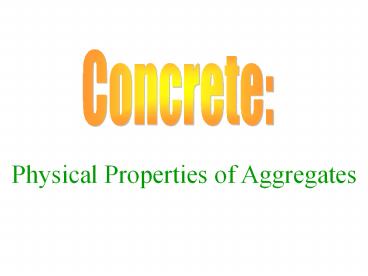Concrete: PowerPoint PPT Presentation
1 / 20
Title: Concrete:
1
Concrete
Physical Properties of Aggregates
2
Concrete
25-40 cement (absolute volume of
cement 7-15
water 14-21) Up to 8 air
(depending on top size of coarse
aggregate)
3
Therefore
Aggregates make up 60-75 of total volume of
concrete.
4
What is an AGGREGATE?
5
(No Transcript)
6
Physical Properties of Aggregates
- 1.Unit Weight and Voids
- 2. Specific Gravity
- 3. Particle Shape and Surface Texture
- 4. Shrinkage of Aggregates
- 5. Absorption and Surface Moisture
- 6. Resistance to Freezing and Thawing
7
Unit Weight
(unit mass or bulk density)
The weight of the aggregate required to fill a
container of a specified unit volume. Volume
is occupied by both the aggregates and
the voids between the aggregate particles.
Depends on size distribution and shape of
particles and how densely the aggregate is
packed Loose bulk density
Rodded or compact bulk density
Normal-weight concrete bulk density of aggregate
is approximately 75-110 lb per cubic foot.
8
(No Transcript)
9
Voids
Void content affects mortar requirements in mix
design water and mortar requirement tend to
increase as aggregate void content increases.
Void content between aggregate particles
increases with increasing aggregate angularity.
Void contents range from 30-45 for coarse
aggregates to about 40-50 for fine aggregates.
Total volume of voids can be reduced by using a
collection of aggregate sizes.
10
The cement paste requirement for concrete is
proportional to the void content of the combined
aggregate.
11
Specific Gravity (Relative density)
Absolute the ratio of the weight of the solid
to the weight of an equal volume of water
(both at a stated temperature) refers to
volume of the material excluding all pores
Apparent ratio of the weight of the aggregate
(dried in an oven at 212- 230ºF for 24
hours) to the weight of water occupying
a volume equal to that of the solid including
the impermeable pores volume of
solid includes impermeable pores (but not
capillary pores)
Used for calculating yield of concrete or the
quantity of aggregate required for a given volume
of concrete.
12
Particle Shape and Surface Texture
Rough textured, angular, elongated particles
require more water to produce workable concrete
than do smooth, rounded, compact aggregates.
Aggregates should be relatively free of flat
and elongated particles (limit to 15 by weight
of total aggregate).
Important for coarse and crushed fine aggregate
- these require an increase in mixing water and
may affect the strength of the concrete, if
cement water ratio is not maintained.
13
Shrinkage of Aggregates
fine grained sandstones, slate, basalt, trap
rock, clay-containing
Large Shrinkage
quartz, limestone, granite, feldspar
Low Shrinkage
14
What happens if abnormal aggregate shrinkage
occurs?
15
Excessive cracking Large deflection of
reinforced beams and slabs Some spalling
(chipping or crumbling)
If more than 0.08 percent shrinkage occurs, the
aggregate is considered undesirable.
16
Absorption and Surface Moisture
If water content of the concrete mixture is not
kept constant, the compressive strength,
workability, and other properties will vary from
batch to batch.
17
- Moisture Conditions of Aggregates
- Oven dry- fully absorbent
- Air dry- dry at the particle surface but
containing some interior moisture - Saturated surface dry (SSD) neither absorbing
water nor contributing water to the concrete
mixture - Wet or moist- containing an excess of moisture on
the surface
18
(No Transcript)
19
Absorption Capacity maximum amount of water
aggregate can absorb Absorption Capacity ()
(WSSD WOD)/WOD X 100 Surface Moisture
water on surface of aggregate particles Surface
Moisture () (WWET WSSD)/WSSD X
100 Moisture Content of an aggregate in any
state Moisture Content () (WAGG WOD)/WOD
X 100
20
Resistance to Freezing and Thawing
Important for exterior concrete. Affected by
an aggregate's high porosity, absorption,
permeability and pore structure. If aggregates
or concrete absorbs so much water that when the
water freezes and expands the concrete cannot
accommodate the build up of internal pressure,
popouts may occur.

